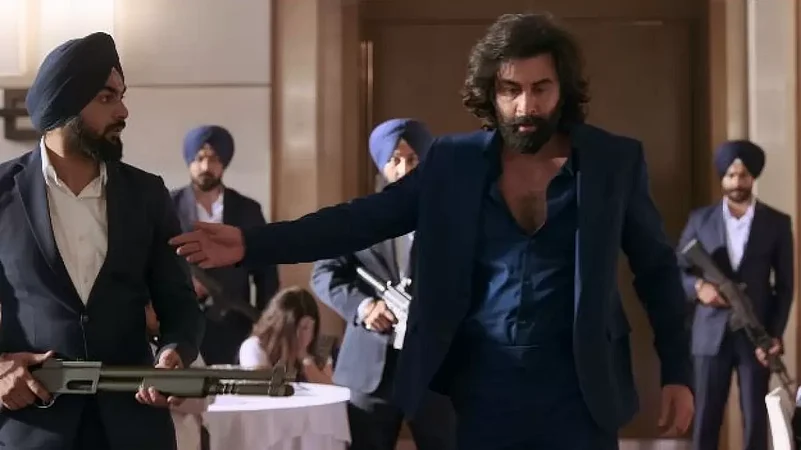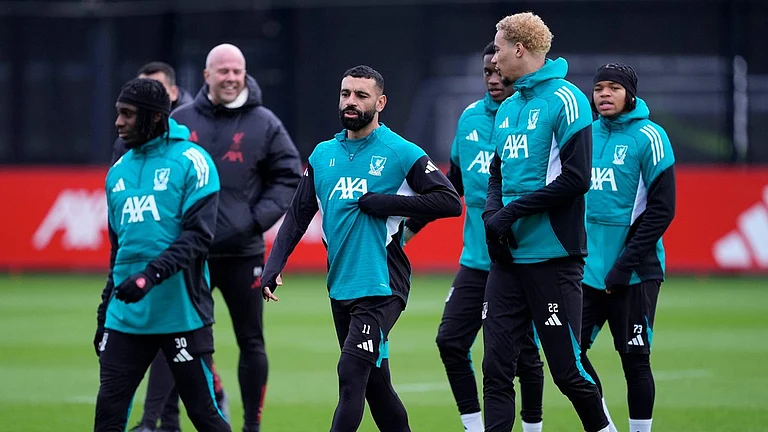It has been well over an hour, and I find myself utterly lost, unable to make any sense of this chaos. Instinctively, I reach for my phone and start scrolling through Instagram, a move I would never dream of making during a film.
There’s a convoluted storyline unfolding on the screen. Rashmika Mandanna’s character, Geetanjali, is engaged in a tense conversation with her on-screen husband, Ranvijay ‘Vijay’ Singh, played by Ranbir Kapoor. He is probing her about an earlier discussion with her parents, which she dismisses. A familiar scene in an average Indian household: a woman standing near the dining table, trying not to stir controversy while serving her husband. But this takes a horrifying turn. He violently pulls and releases her bra strap, and she, in shock, asks him to stop. Multiple times. He doesn’t. He’s trying to make a point, asserting control. Cut to the next scene, her back is exposed, the violent red mark from the earlier incident visible, while her husband nonchalantly applies ointment and she weeps.
In one of the poshest cinema halls in Delhi, two young women seated beside me are giggling at the screen. I am appalled. What sort of Christian Grey fantasy is this? It is domestic violence and they are finding the husband’s possessive display of ‘affection’, sans her consent, amusing.
This is just the appalling tip of the disturbing iceberg that is Sandeep Vanga Reddy’s latest blockbuster ‘Animal’.
In another scene, the same husband casually remarks —while courting this woman on the evening of her engagement to another man— that she has a big pelvis perfect for carrying healthy babies. In his warped worldview, he is the alpha, destined to outshine weak men who resort to wimpy means like poetry to woo women.
Spare me the reasoning of artistic expression and tell me how someone woke up one day and decided to make this regressive film.
Furious, I close my eyes, trying to erase these images to no avail, and my mind drifts back to the only pleasant memory of this film. The captivating cradle of Alborz, and the sound of the Kharazemi Girls’ High School Choir ringing in my ears:
“Vay Siyah Zangi Delamo Nakon Khun
Vay To Rafti Safar Shodam Cho Majnun
Hala Jamal Jamalo Jamalo Jamalo Bodo”
(Oh, my darling, refrain from toying with my heart;
You’re setting forth on a voyage, and I feel overwhelmed;
My love, my dearest, it's driving me to madness.)
The melodious strains of Bijan Samandar’s poem during the entry of the film’s antagonist are my only solace in this abomination masquerading as a movie.
Why should I take in one of cinema’s most repulsive protagonists with a pinch of salt? Especially if the protagonist is a disappointing replica of Michael Corleone minus his mafia code, filthy rich and with occasional sad glimmers of Tony Montana. Please add to the concoction the director’s propensity to attempt to topple Quentin Tarantino at his game, without the compelling narrative touch.
My problem is with the reception audiences have been giving the film. I watched in horror, women —young and old— clapping at instances where the women in the film were physically, emotionally, and intellectually reduced. I heard women say, “But he’s so hot, ya…ar! Itna toh chalta hain na” (This is acceptable), as if the protagonist was casually cheating at a game of ludo.
Our exposure to violence in various forms of media such as cinema, television, and video games, has increased over the years. This contributes to desensitisation, wherein individuals become less sensitive to violence and may, therefore, be more accepting of it in cinematic narratives. The blurring of lines between fiction and reality can lead to a disconnect, making violent scenes appear less shocking or repulsive.
Traversing timelines from Vijay’s childhood to his autumnal years, ‘Animal’ attempts to unravel the origins of his violent tendencies, attributing them to a desperate thirst for love and validation especially from his controlling father, Balbir Singh, played by Anil Kapoor. He is angry (without a cause) and irritated because he has to run a steel empire and keep consolidating his position as the richest man in the country.
Desperately in need of therapy and not guns, the obsessive Vijay casually delivers many one-liners endorsing alpha-male ideals and questionable views on women’s submission. Despite its intention to shock, the film falters in substance, relying on gratuitous violence that feels derivative. It lacks the courage to fully embrace its transgressions, evident in misguided attempts such as incorporating a swastika as a company logo, accompanied by a feeble explanation.
While the film initially holds the promise of charting a fresh, psychology-driven path for Hindi action movies, it succumbs to the lure of shock value and franchise aspirations. Vanga’s protagonists, consistently depicted as entitled creatures, fall into the realm of badly-behaved men resembling monsters. Animals, to be precise.
Vijay epitomises this so-called archetype, a rich brat with profound issues stemming from his emotionally distant father. ‘Animal’ endeavours to narrate Vijay’s life, emphasising relationships, familial dynamics, and his descent into violence. However, the film stumbles in portraying love and romance, lacking the nuance required for authentic emotional storytelling.
As the narrative unfolds, ‘Animal’ strays from its potential psychological exploration without a shred of sense and regret, giving way to provocations and stylistic choices seemingly designed to generate controversy. Vanga’s juvenile filmmaking approach overshadows any attempt at genuine character development with Vijay’s territorialism and toxic masculinity running riot. Despite moments of heightened tension and violence, the film loses its edge during action sequences, failing to match the intensity of classics in that field. The editing, occasionally circuitous, contributes to the film’s bloated feel in its three-hour-plus runtime. And Kapoor’s performance echoes shades of his previous roles, combining swagger, cockiness, and angst. But to what end?
Despite flickering glimpses of potential, the film fails to break free from regressive tropes, leaving audiences with an empty spectacle. It transcends its narrative to become a cinematic rant against critics of Vanga’s previous hit ‘Kabir Singh’ (2019). Every frame exudes bitterness, provocation, and rage, turning the film into an expensive diatribe that inadvertently incriminates the legacy of its predecessor. Vanga appears to recall the criticism of ‘Kabir Singh’ vividly, weaving scenes that seem like a deliberate retaliation against each critique. However, this cinematic vendetta becomes a convoluted mix of provocations that overshadow coherent storytelling.
Vanga’s narrative choices seem more concerned with defying criticism than crafting a meaningful cinematic experience. My heart goes out to Tripti Dimri who is now the national crush for essaying a character who lacks the depth that her usual roles convey.
Like its protagonist, the film is needy and attention-seeking. Its rampant and unforgiving misogyny, music, and gore are crying out for recognition. Close-ups, symbolic of the film’s insistence on not allowing viewers to look away, further contribute to its desperate neediness. The performances are constrained by a narrative that seems more interested in baiting viewers and critics than developing characters. The film’s narcissistic quality is evident as it simultaneously sneers at critics and yells ‘massy’, seeking refuge in a label that absolves it of responsibility.
Some may argue that the acceptance of violence in ‘Animal’ stems from its cathartic nature. The allure of escapism, paired with storytelling and visual effects, amplifies the appeal of violent scenes. The easy acceptance of violence in ‘Animal’ may be tied to a desire for cinema to reflect and confront societal challenges. In the digital age, the rapid sharing of opinions and trends on social media platforms can shape what is considered acceptable or popular, contributing to the acceptance of specific types of violence among Gen Z audiences. Sadly, if violent content like this consistently succeeds at the box office, filmmakers and studios may continue producing similar content to meet the demand.
(Views expressed are personal)
























